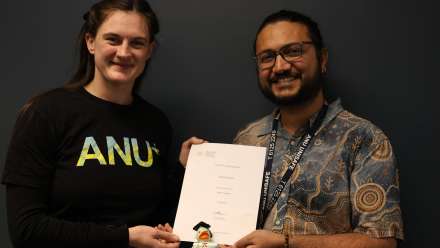Industry partnership towards cancer treatment
After all these years, I'm still really excited about the work we're doing. And who knows what we'll be able to do with this technology in the future.
Professor Ross Stephens knew he was onto something big. Something that could help save thousands of lives.
"I already had enough knowledge of the technology to see that there could be very valuable medical applications," he said.
The research soon attracted the attention of an industry player - one of Australia's largest biomedical companies, Sirtex, in 2006. Sirtex were looking to enhance their novel cancer treatment, SIR-Spheres® - tiny plastic cages loaded with tumour-killing radiation - which were already working wonders for late-stage liver cancer.
The key to the SIR-Spheres' success is targeting the radiation therapy directly at the tumour site.
"External radiation - which is the conventional treatment for cancer - has to pass through the body and it does a lot of damage on the way through to normal organs and tissues," said Ross.
"The SIR-Spheres are designed to lodge at a certain diameter of the vessel and emit their killing radiation.
"The idea is that you try and localise your radiation treatment right at the spot where it's needed rather than exposing half the body."
That's where imaging comes into play - how can you be sure your treatment is localising to the right place if you can't see where it ends up within the body?
"Our part was to make a new material incorporating imaging radioisotopes and work out how to then stick that onto the surface of the spheres," explained Ross. "Like pimples on a pumpkin.
"It's not as trivial an exercise as it sounds. The particles have to be cemented on in a very stable way. You don't want them to become unattached and travel around the body."
Ross and his team not only succeeded in incorporating stable imaging capability into the SIR-Spheres, they went one better, devising methods for using imaging isotopes that can last long enough for distribution to clinics.
A trial to test out the new technology with cancer patients at Sydney's North Shore hospital is planned for 2014. After more than 20 years working in cancer biology, Ross is humbled by his team's achievement.
"My wife is a haematologist and does a lot of work with leukaemia patients and I've been very well aware all through my career that there is a limited availability of things that are going to make any impact in cancer treatment," he said. "To see this technology get to this point is just fantastic."
Ross and his team - David king, Karen Knox and Jessica Bell - are not the only ones who are pleased with the outcome. Earlier this year, Sirtex announced the creation of the Sirtex Chair at ANU. As the inaugural Chair, Ross will receive up to three million dollars towards his research over the next three years.
During the announcement, Sirtex's Chief Executive Officer, Gilman Wong, said that it was groups like Ross' that "have the ability to drive real and rapid change in our world".
The team at Sirtex have proven to be just as dedicated to the project. From the moment they made the decision to come on board as an industry partner, there was an instant connection, said Stephens.
"These days, trying to do something new in the medical area, no one person or group can have all the expertise needed. You have to have the connections," said Ross.
"Our collaboration with Sirtex has been fantastic. They have introduced us to so many people doing things that can really complement our work."
The research is being conducted at the Department of Applied mathematics, led by Professor Stephens and head of the Department Professor Tim Senden.
Tim said that the Chair and its associated funding presents an exciting opportunity to find new uses for the technology.
"While this research is highly focused on new adaptions of Sirtex's existing technology, it also allows us the flexibility to follow our fundamental research along unpredicted pathways that could lead to new uses for the technology," said Tim.
As luck would have it, the team have already discovered another use for their nanoparticles - this time in researching lung damage in sepsis.
It's been a long journey, and one that was very nearly abandoned, but for Tim and his team the future of their research, with the help of Sirtex, is looking bright.
"After all these years, I'm still really excited about the work we're doing. And who knows what we'll be able to do with this technology in the future."


